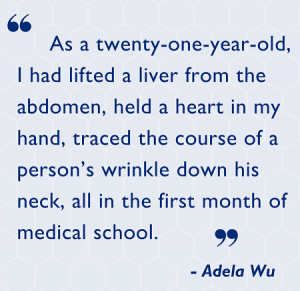The seasons I spent running high school cross country have long gone, and I'm far from a great long-distance runner now, but I remember three things our coach was always shouting at us.
"You're only as fast as the slowest person!"
While it seemed like every runner was on the trail by herself, it was always, ultimately, a team effort. He encouraged us to follow and cheer on our teammates at the top of every hill and, if on the course together, to push each other to keep moving. Medical school isn't quite like breathing in kicked-up dust or struggling to crest a steep rocky incline (and I've never again appreciated Gatorade or PowerBars to the same extent). I do have my teammates here in Baltimore, though, and they're invaluable, truly special friends.
The journey includes multiple finish lines.
The second thing she would encourage was for us to keep our eyes on a stationary marker in the distance, like a colored flag or a church building or parked truck blocks away. Once I passed the marker, I would train my sights on a new object, one by one, until I completed the three-mile, five-mile or ten-mile runs. I often think of my long education, and particularly medical school, as a clichéd marathon. I'm reaching the finish line soon as I type this, just days after submitting my residency applications on September 15th, a ritual every medical student goes through before embarking on the next leg of training. The days that blend into each other, those filled with the necessary studying and bureaucratic mundanity, are punctuated with milestones, celebrating the start of medical school with the White Coat ceremony, the beginning-of-year barbeque, the end-of-year parties, third-year rotations, the fourth-year introspection, and preparations for our nth-year lives. These milestones are important. They ground me and give me constant things to look forward to.
 Lean into the challenge.
Lean into the challenge.
This brings me to the third from our coach, which was to “lean into” the tough up-hills and let gravity carry you easily downhill. Needless to say, there are good and bad parts to any experience, and medicine is no exception. I had to find a gravity that went beyond the established milestones of school. I recently attended the Body Worlds: Pulse exhibit in Los Angeles, which featured the well-known plastinated human body and organ specimens. There was a body arranged as a dancing figure, and even an exhibit with the three poker players featured in the movie Casino Royale. Whether encased in glass or left open in the space, though, every exhibit was marked with a prominent “Do Not Touch” sign, around which thronged crowds of marveling onlookers. As a twenty-one-year-old, I had lifted a liver from the abdomen, held a heart in my hand, traced the course of a person’s wrinkle down his neck, all in the first month of medical school. I peered at preserved specimens of lungs, intestines, and kidneys in the cases at the California Science Center. The woman standing next to me breathed, “This is unbelievable.” This is my gravity. This is what I tend to forget when I become caught in the grind. The fact that I get to see violescent veins on the surface of a live, pulsating brain. The fact that strangers choose to trust us with their lives. This is unbelievable.
I forgot. There was a fourth thing, too. Inhale on every other right foot strike. It prevents cramping, at least for me.
